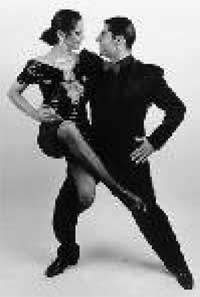
| HOME | MENU | DOCS | SEARCH |
see Recommended reading in dance. Symbols and abbreviations
Tango (from исп. tango; lat. tangere - to concern), pair dance, expressional and sensual, enters the West European program of sports ballroom dances. Official muses. the size of a tango 2/4, but many will arrange it at a rate of 4/4; rate of 32-34 t/min.
It is considered national dance of Argentina and other countries of Latin America, but has multinational roots. The government of Argentina in 1978 declared in the National afternoon of a tango on December 11 (birthday of Carlos Gardel), this day is still celebrated by all admirers of a tango.
In Buenos Aires there is the only museum of a tango in the world and a monument of a tango. The tango is included in the program of training at universities and schools, as national dance.
The African dance Tangano which got to Spain and widely adopted among indigenous Spaniards was the far predecessor of a tango. The word "tango" has the African origin and means "meeting place". In the XVI century with the Spanish gain of South America vigorous Spanish dances were delivered to Argentina. From an expressive Spanish flamenco, Black rhythms and a gusty Cuban habanera there was a dance called subsequently the Argentina tango.
For the first time the tango in its modern form was executed in Buenos Aires at the end of the XIX century, then it was called as "Baile con corte" - "dance with a stop".

At a boundary of XIX and the XX centuries this dance which became already Argentina again gets to Europe. The famous French choreographer and the composer Kamil de Rinal, having processed dance in traditions of the French ball school and having simplified it, I created a peculiar tango which soon was generally recognized. The tango had a great number of supporters not less opponents who were revolted by inadmissible pressing during dance and in general its excessively sensual character. Paris becomes the capital of a tango. In the 1910th dance becomes fashionable in all Europe and in America, though not freely.
I was considered as a tango as obscene, immoral, shocking dance. In 1914 the decree of the minister of national education of Russia L. A. Kasso of a tango forbade youth even to study. (If to remember, the lot of a tango was shared in due time by both a waltz, and a mazourka, and the Pole). In 1920 the tango in Russia becomes part of the New Economic Policy - "the corrupted bourgeois culture". Dance of a tango, "held down by external concentration caressing and as if a sad rhythm … remains determinant of style of the 1st half of the XX century" (M. Bonch-Tomashevsky).
In the 1930th years in Paris changes were made to dance, the position became more ball. The tango becomes a combination of the stately, pride bearing introduced in it from other dances, and sharp, abrupt movements. The tango fitted into the European culture, though underwent numerous changes and amendments: from Argentina to French, from French to a tango of the English standard. Now speak about the Argentina and European tango as about two versions.
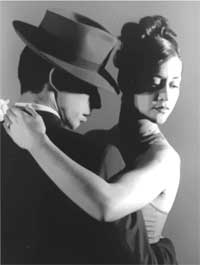
The movements of a tango are based on a combination of fast and slow paces, and also pauses. Soft, rhythmical, the step without sliding is combined with sudden stops, promenades, change of the directions, unexpected poses. The tango expresses extreme feelings and explosive passion, but demands a stable mimicry and the maximum immovability of a body. It is danced with pauses and changes of a rhythm (acceleration, delay). A tango - dance passionate and sensual, temperamental and drama, but always painted by grief.
The tango is the cornerstone of fine movies; it not only is danced, but played and sung. The most known melody of a tango - "La Cumparsita" written in 1917 by Uruguayan Zh. Rodriguez has more than 200 options today.
The tango demands a perfect dress coat and the stylish fitted dress of the modern woman. A tango it is very strict, and any frivolity in a suit, any evasion in unnecessary tinsel of magnificent dresses or excentric hairdresses doesn't match all content of dance.
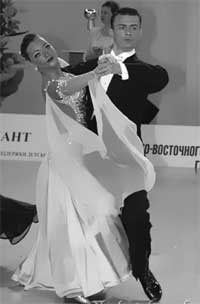
Despite common features with other European dances, the tango considerably differs from them in situation in couple, equipment and manner of performance.
The tango was always very loved and is popular in Russia. "Champagne splashes", "The tired sun", Oscar Strok's melodies, a tango performed by Vadim Kozin, Pyotr Leshchenko, Alexander Vertinsky, the wartime tango, from our cinema and a platform - at us is the Russian tango. Many foreign тангерос note musicality of Russians, passionate nature and predisposition to a tango.
Somewhat out of fashion in 30-60 years, at present the dance once again received wide recognition. Size: 4/8 or 2/4.
Temp: 34 tact or 136 beats per minute with an accent on the first and second lobes.
Basic rhythm: slow, slow, quick, quick. Slow every account corresponds to one quarter, and each quick — one-eighth.
Position: the position of the hands in tango is more compact and lower than in other standard dances. The body of the partner deployed a bit right shoulder is coming forward and diagonally to the center. The partner holds the right, some to the right and slightly stretched.
Note: In the closed position right foot is slightly behind the left. The knees are relaxed during the dance. Lifts and tilts no.
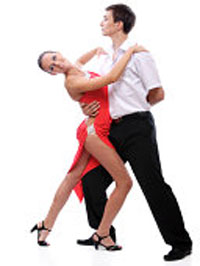
1. Progressive side step or Argentine
This movement is also called the step "the crab" due to the very distinctive style of movement in the direction that gives the tango a special flexibility.
Start and finish the movement face diagonally to the center, but with a slight deviation to the right of the line of dance. Progressive side step is preceded by two major steps forward. The foot detaches from the floor when you step forward and falls to the floor with the transfer of her body weight.
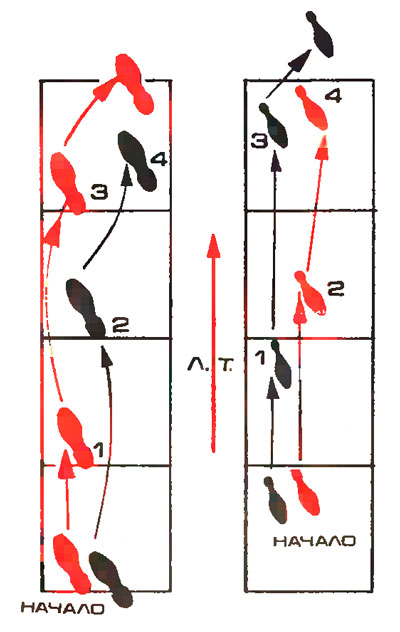
Fig. Progressive side step or Argentine. PA partner and partner
1. Step left foot forward, slightly in front of the right (slow).
2. Step right foot forward, "crossing" the line of dance (slow). Then go to the progressive side step.
For the Partner:
3. Step left foot forward, slightly "crossing" case in front of right (quick).
4. Step right foot to side and slightly back to the left (quickly).
5. Step left foot forward, cross slightly in front of right (slow).
For the Lady:
Takes the opposite steps.
Note: the Shoulders must be strictly vertical to the soles of her feet. Partner takes a position slightly stretched.
2. Court ago, or a change of direction
It is used when the partner reaches the edge of the site and wishes to turn to the new line of dance. The movement begins with a back line of dance and end with the face line of dance in a new direction.
For the Partner:
1. Step the left leg back along the line of dance left shoulder lead (slowly).
2. Step right leg back diagonally to center, turn body to the left (quickly).
3. Step left foot to side and slightly forward, body turning left to the new line of dance diagonal to the wall (fast).
4. Pristavit right foot to the left, slightly behind (slow).
For the Lady:
Takes the opposite steps.

Fig. Court ago, or a change of direction. This PA is executed in "Argentine" style. Start back diagonally to the center and end face diagonally to the wall (for partner)
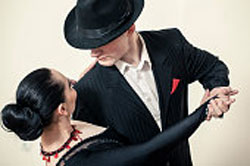
3. Open left turn (closed finish)
The movement is most easy to perform for beginners, as it has similarities with the twists and turns of the quickstep and slow Foxtrot.
For the Partner:
Moves face diagonally to the center and ends of a face diagonal to the wall, but slightly to the left toward line of dance.
1. Step left foot forward, "crossing" case, turn to the left (quickly).
2. Step right foot to side and slightly back, the housing back along the line of dance (quick).
3. Step the left leg back along the line of dance left shoulder lead partner on the side (slowly).
4. Step the right leg back, back diagonally to the center with a left turn, partner in line (quickly).
5. Step left foot to side and slightly forward (quickly).
6. Pristavit right foot to the left face diagonally to the wall (slowly).
For the Lady:
Takes the opposite steps. On "three" — she takes a step forward on the side of the partner, and "four" — returning to its previous position.
Note: This figure usually marks the partner with access to the side of the partner in PDC.
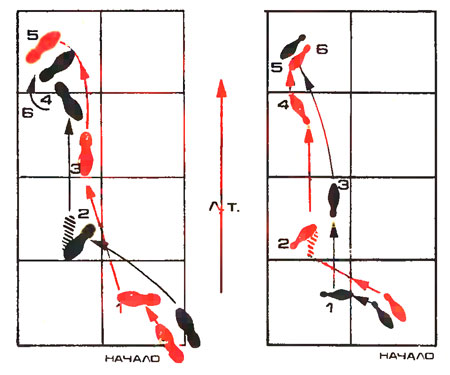
Fig. Open left turn
4. Rock (step tango or Habanera)
It does not move, but rather an oscillatory motion, but it is reproduced here, as is typical for tango. It must be followed by another movement, for example, the court ago, described above.
For the Partner:
Begins and ends the movement with its back diagonally to the centre but with a slight turn to the left. Knees relaxed, feet aimed at the inside edge of the pads alternately.
1. Step left foot back diagonally to the center, his left shoulder leading (quickly).
2. To transfer body weight forward to right foot, right shoulder leading (quickly).
3. To transfer weight back on left foot, slightly extending step, left shoulder leading (slowly).
For the Lady:
Moves face diagonally to the center and ends of a face diagonal to the center, but with a slight turn to the right.
1. Step right foot forward to face diagonally to the center, right shoulder leading (quickly).
2. To transfer weight back to left foot, left shoulder leading (quickly).
3. To transfer body weight forward to right foot, slightly extending step, the right shoulder leading (slowly).
The affiliate shall not make the first step too big. You should always do the 3rd step Rocca in the same direction in which you move forward.
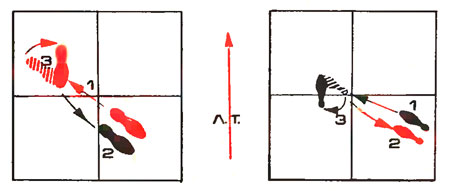
Fig. Rocco-rotate (step, tango, Habanera). PA partner and partner
1. Rock-rotate
This simple variation includes jiggle and the last three steps of the reverse turn closed or the court (paragraph 4-7).
For the Partner:
Starts moving along the line of dance or diagonal to the wall and ends up face diagonally to the wall.
1. Step right foot forward, body turning right (slowly).
2. Step left foot side left and slightly back, left shoulder leading, back diagonally to the center (fast).
3. Continuing the rotation of the body right, do the wiggle (rock) forward on right foot, right shoulder leading (quickly).
4. Rocking back on left foot, lengthening the step a few cm back, back diagonally to the center, his left shoulder leading (slowly).
5. Step right foot back diagonally to the center with the body turning to the left (quickly).
6. Step left foot side left and slightly forward (quickly).
7. Pristavit right foot to the left slightly behind her, face diagonally to the wall (slowly).
For the Lady:
Starts moving back along the line of dance or diagonal to the wall; ends back diagonally to the wall.
1. Step the left leg back with the body turning to the right (slowly).
2. Move your right foot to the side right and slightly forward between partner's feet, his right shoulder leading (quickly).
3. To fulfill rocking back on left foot, sliding it slightly to the left, his left shoulder leading (quickly).
4. To sing rocking forward on right foot step extending for a few cm to the right, the body diagonally to the center, right shoulder leading (slowly).
5. Step left foot forward diagonal to centre and turning the body to the left (quickly).
6. Step right foot to side right and slightly back (quickly).
7. To fasten the left leg to the right slightly ahead of her, back diagonally to the wall (slowly).
MPC 1, 5. The fifth step in PDQ. Execute 1/4 turn to right between steps 1-3; 1/4 turn to left between steps 3-6. Partner is on the inside of the turn, so her right foot is between the feet of the partner. With rocking (steps 2-4) knees much relaxed.
2. Outdoor promenade
This variation is usually performed by the line dance.
For the Partner:
Starts moving in the boardwalk, turning in this position after the execution of the stroke with the right foot or the progressive link. The body weight on the right foot, building partner and partner form the letter V. Completes the movement diagonally to the wall.
1. Step left foot side left in the position of the promenade (slow).
2. Step right foot forward, crossing the position of the promenade and starting a turn to the right (fast).
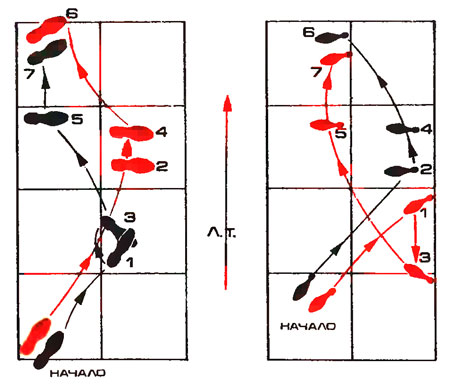
Fig. The rock-rotation. PA partner and partner
3. A small step left foot side left and slightly forward, forcing the partner to perform a quarter turn to the left to face partner (quickly).
4. Step the right leg forward to the side of the partner (slow).
For the Lady:
Starts moving in the boardwalk, turning in this position after the execution of the move left leg or progressive level: the body weight on the left leg. Ends back diagonally to the wall.
1. Step right foot to side right in promenade position (slow).
2. Step left foot forward, crossing the position of the promenade and starting the turn to the left (quickly).
3. A small step right foot to side right and slightly back, turning directly to the partner (quickly).
4. Step the left leg back side of a partner (slowly).
Progressive link with access to the position of the promenade.
For the Partner:
Starts moving back to the centre, ends up in the position of the promenade.
1. A small step with your left foot forward in front of right, as if "crossing" case (fast).
Have a partner step right foot behind left.
2. A small step right foot to side and slightly back (quickly). Have a partner step left foot to the side — the position of the promenade. The next step with the left foot in promenade position. PPDC in the first step. 1/4 turn to the right, their partner, leaving in the position of the promenade — p. 2 link.
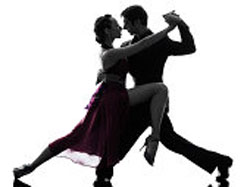
3. Closed promenade
This figure marks the line of dance. It can serve as the beginning and ending of a large number of variations.
For the Partner:
Starts moving diagonally to the center in the position of the promenade; the body weight on the right foot. Ends diagonally to the wall or, following the desired bundle, and the line dance that often. In this case the partner makes his third step along the line of dance and brings the right foot to the left in the same position as with a progressive link, i.e. back to the centre.
1. Step left foot side left in the position of the promenade (slow).
2. Step the right leg forward and cross in the boardwalk (fast).
3. Step left foot side left and slightly forward (quickly).
4. Pristavit right foot to the left slightly behind it (slowly).
For the Lady:
1. Step right foot to side right in promenade position (slow).
2. Step left foot forward in cross position to the boardwalk (fast).
3. Step right foot to side right and slightly back, turning right in front of a partner (quickly).
4. To fasten the left leg to the right slightly ahead, ending with its back diagonally to the wall (slowly).
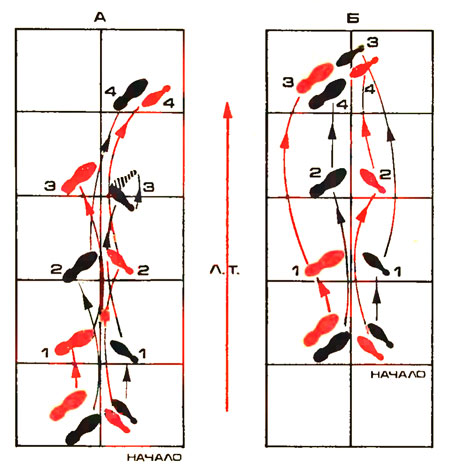
Fig. A) an Outdoor promenade. PA partner and partner; B) Closed promenade. PA partner and partner
Note: If a partner moves along the line of dance, the lady will follow him and will occupy a position directly opposite him. If the partner performs the movement with turning, changing direction, partner will perform the broader movement of the right leg (p. 3).
The second step in PPDK in the open promenade of the 2nd and 4th. The first step should be long and slightly back so that the partner has performed its second step with ease. The third step is performed abruptly, clearly on the inner edge of the left foot (knee turned inwards). In the console, right-foot left shoulder slightly leans back.
4. The right twist-and-turn
This variation is very difficult, but enjoyable to play especially with a partner who feels jerky rhythm of the tango. The figure consists of the right of the twist rotation (here in the sense of "twisted"). Indeed, at some point, the partner performs a static rotation, staying in place, while the partner rotates around it and causes the spin of the partner.
For the Partner:
Starts movement to the position of the promenade and continues along the line of dance, ends in the line of dance or diagonal to the center.
1. Step left foot towards left along line of dance in promenade position (slow).
2. Step the right leg forward and cross in the position of the promenade with right turn (fast).
3. Step left foot side left, crossing the line of dance back diagonally to the center (fast).
4. Cross right foot behind the left (cross) at a few cm from it now back against the line of dance (slow).
5. 6. Turn the cushion right foot and heel of left foot to end in the normal position, the boardwalk, feet together, weight on right foot (quick, quick).
The movement to continue along the line of dance, doing an indoor promenade with the left foot.
The second step PPDC. Full turn to the right. Feet to keep flat, at the end of the turn they are on small distance from each other, and the left knee turned inwards to the right.
For the Lady:
Starts moving along the line of dance in promenade position and
ends of the line of dance or diagonal to the center.
1. Step right foot to side right in promenade position (slow).
2. Step left foot forward in cross position to the boardwalk, the foot is directed along the line of dance (quick).
3. A small step with your right foot forward between partner's feet (quickly).
4. Step with the left foot, prigotovtes to take a step to the side of the partner, left shoulder leading (slowly).
5. Step the right leg forward to the side of the partner, face to the wall (fast).
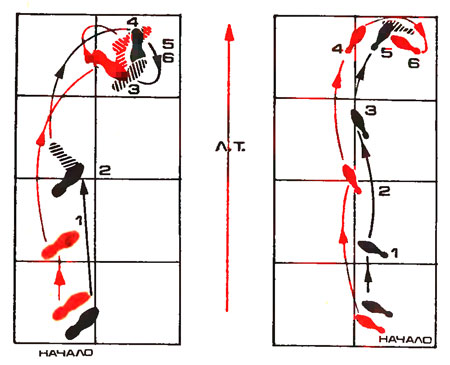
Fig. The right twist-and-turn. PA partner and partner
6. Turn the cushion right foot, put left foot to the right, performing a little over half-twist to the right. To finish in the boardwalk face diagonally to the center, feet together, weight on left foot (quick). To continue on the line of the dance a closed promenade with your right foot (slow, quick, quick, slow). Partner must not forget that it takes a turn very close from the partner. During the twist it is on the side of the partner and takes your right foot step around the partner, avoiding him.
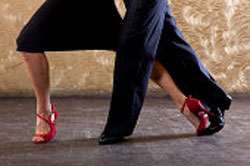
5. Falloway promenade
The term "followee" (translated as to leave, to leave) gives you an opportunity to understand the movement of the pair, which in the position of the promenade back. Variation simple. Start the movement in the position of the promenade line of dance and end in the promenade.
For the Partner:
1. Step left foot side left in the position of the promenade (slow).
2. Step the right leg forward and cross to promenade position, slightly turned to the right (fast).
3. Step left foot side left in the position of the boardwalk and back diagonally to the center (fast).
4. Step the right leg back to the center in followee; right shoulder leading, body back diagonally to the center (slowly).
5. Step the left leg back to the center in followee (fast).
6. Pristavit right foot to the left slightly back in promenade position, body facing the wall (fast).
Motion to continue with the left foot in promenade position diagonally to the wall.
The second and fifth steps in PDC. PDK 2. Execute 1/4 turn to right between steps 1-4; 1/8 turn to left between 4-5, body completes turn on 6. On the fourth step do not lose contact with your partner, making it in the open position. The fifth step is to execute much "body" in PDC.

Fig. Falloway promenade. PA partner and partner
For the Lady:
1. Step right foot to side right in promenade position (slow).
2. Step left foot forward in cross position to the boardwalk, crossing the line of dance and turning slightly to the right (fast).
3. Step your right foot forward in promenade position, starting to move along line of dance and ending diagonally to the wall (fast).
4. Allowing them to spread themselves to the right, step the left leg back to the center in followee, left shoulder leading, body back diagonally to the center (slowly).
5. Step the right leg back to center, case in followee (fast).
6. A little turn to the left, put your left foot to the right slightly back; finish in promenade position, the body face line of dance (quick).
Starting with the right foot, to link with another variation on the promenade, moving diagonally to the wall.
Steps 2, 3, 5 in PDC. MPC on the 3rd and 5th steps. 1/4 turn right between 1-4; 1/8 turn left between 5 and 6. The third step is to start along the line of dance and end on a diagonal to the wall in PDC. Turn on the fifth step on the ball of the right foot.
6. Link-promenade (promenade link)
This PA is used in the transition from the variation of the boardwalk to the figure in the promotion, and also to enter in for-step. Hence the name "link" (here meaning to link). Start the movement in the position of the promenade line of dance and end facing the wall.
For the Partner:
1. Step left foot side left in the position of the promenade (slow).
2. Step the right leg forward and cross in the boardwalk, starting a turn to the right (fast).
3. Turn right in the direction facing the wall, bring the left foot to the right, not shifting her body weight; at this point, turn the partner right in front of me a quarter turn to the left (quickly).
Continue the movement with the left leg, performing the four-step or progressive link.
For the Lady:
1. Step right foot to side right in promenade position (slow).
2. Step left foot forward in cross position to the boardwalk, starting a turn to the left (quickly).
3. Turn left in the direction back to the wall, bring the right foot to the left, not shifting her body weight, and be right in front of the partner in the closed position (quickly).
Continue the movement back with the right foot, fulfilling Forster or progressive link.
Easy GTDC in the second step, and it also PDK. To fulfill 1/8 of a turn to the right partner, left partner.
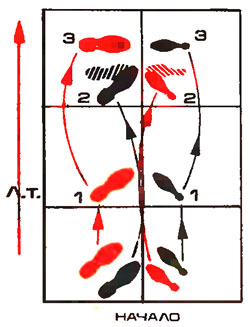
Fig. Promenade link (link). PA partner and partner
7. The four-step (four steps))
This variation is very nice and is often used after the prom level.
For the Partner:
Starts to move to face the wall, the weight of the body on the right foot, and ends in promenade position along line of dance.
1. Step left foot forward, slightly "crossing" case (fast).
2. Step right foot to side right and slightly back, face diagonal to wall (fast).
3. Step left foot back (partner side), moving diagonally to the center against line of dance (quick).
4. Pristavit right foot to the left slightly back; at this point the partner to turn to promenade position (fast). Continue the movement with your left foot to side along line of dance, fulfilling one of promenade figures.
Easy MPC on 1. The first and third steps in PDC. To fulfill 1/8 of a turn to the left. In the second step, the right foot is placed flat pad feet.
For the Lady:
Usually starts to move after a promenade link back to the wall, the weight of the body on the left leg.
1. Step the right leg back, slightly "crossing" case (fast).
2. Step left foot side left and slightly forward, foot diagonally to the center (fast).
3. Step the right leg forward to the side of the partner (quickly).
4. To fasten the left leg to the right slightly back; turning at the same time right on the ball of the left foot, to become in a position promenade, body face diagonally to the center (fast).
To continue the movement to the side with the right foot along line of dance, performing any promenade figure.
On the first and third step PPDC. To execute 1/8 turn to left between steps 1-2; 1/4 turn to right between 3-4 steps. In the second step, the body should be facing the centre, so as not to lose contact with your partner on the third step, the side of the partner.
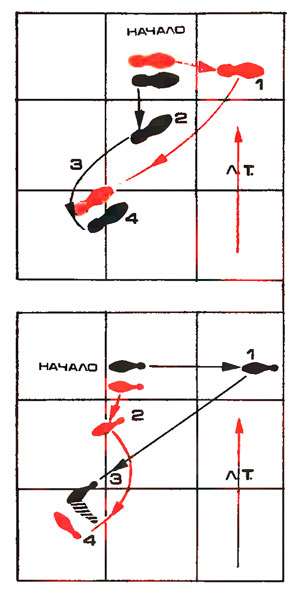
The four-step (four steps). PA partner and partner
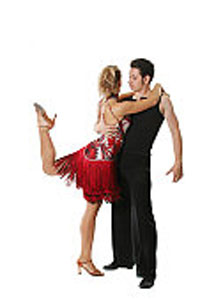
Chords and variations
1. Progressive side step — rock-turn — court ago.
2. Closed promenade — left turn outdoor.
3. Rock-turn — court back — left turn — progressive link in the position of the promenade and closed promenade.
4. Right twist turn — closed promenade — left turn outdoor or progressive side step.
5. Followa-promenade — closed promenade.
6. Followa-promenade — promenade link — four step — right twist turn — closed promenade — rock-turn—court with direction change. Repeat.
7. Promenade link — four step — followee-promenade — Fort-step or the outdoor boardwalk.
Video provided by the school of ballroom dance Alexei Zhestkova
Ballroom dancing in the Kremlin! A new set. Personal trainers consultation. Friendly atmosphere
<< Back: West European ballroom dances
Maria Vasilevskaya "Dances from And to I" the Book about dances for laymen
We recommend that you look at the popular sections of the site myvaleology.com: MENU with a description of the sections | |||
| SOCIAL | DONATION | MY DIET | MY SPORT |

|
Release all4e8 |
||
Copyright © VZOJ 2023. All rights reserved. When reprinting or quoting myvaleology.com materials please put a link to the site myvaleology.com :
<a href="https://myvaleology.com">Healthy lifestyle</a>